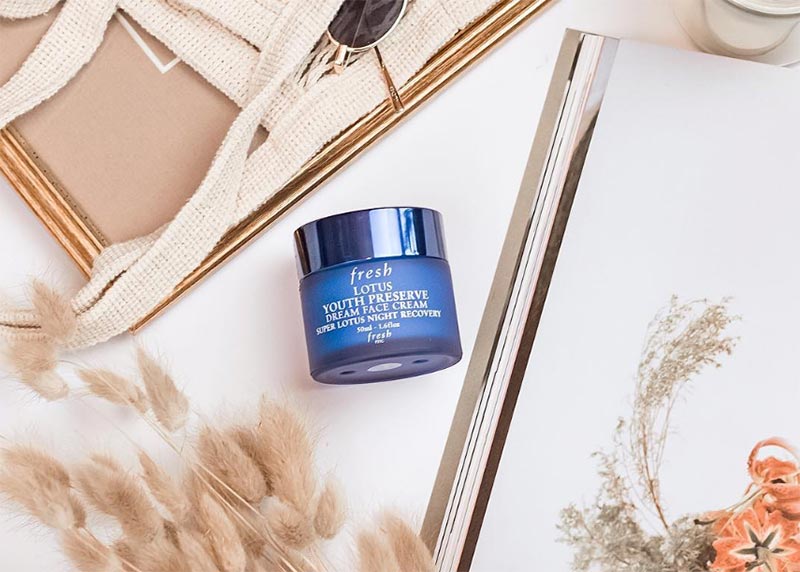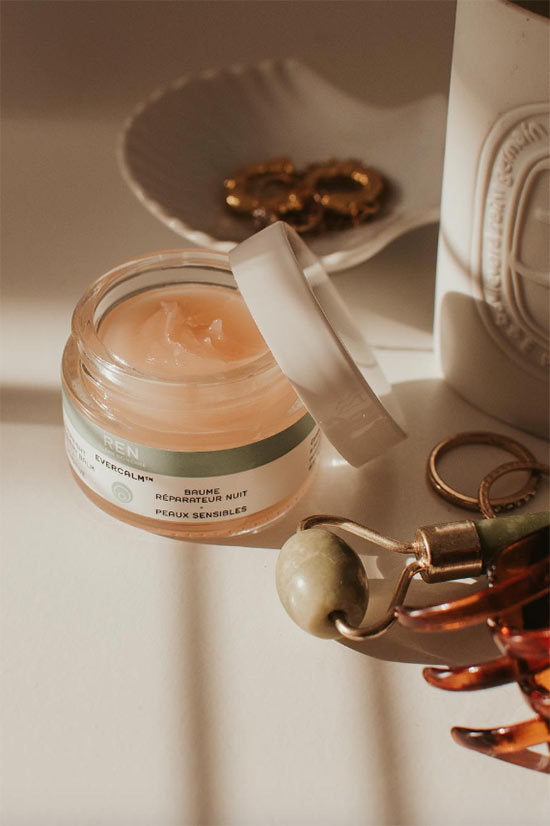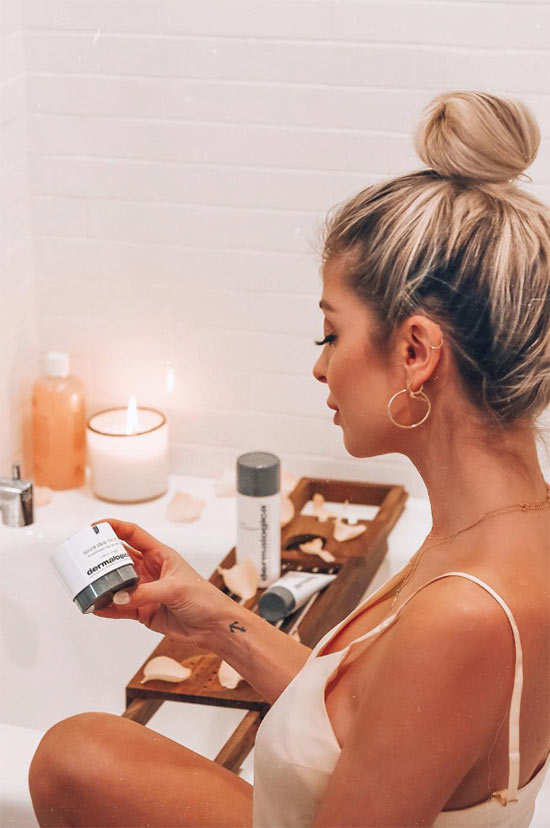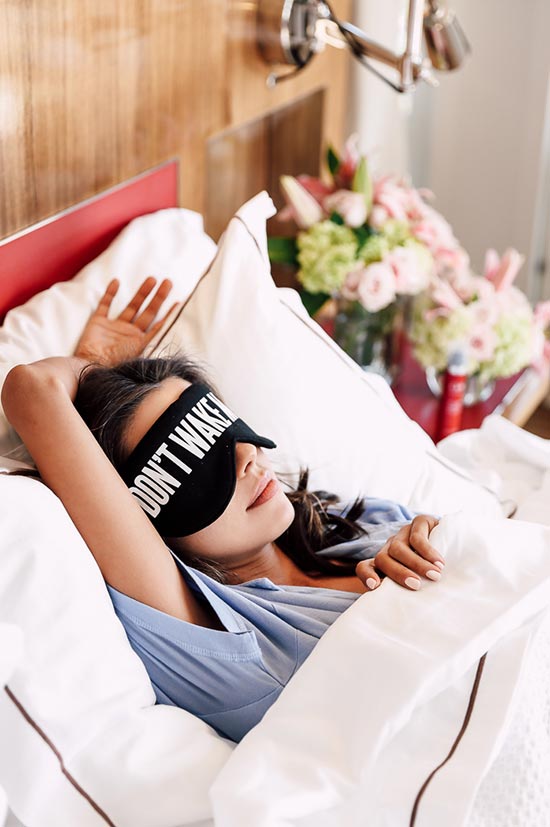The concept of “night cream” seems so vintage to me. I can just picture a woman from the 1940s sitting in front of her vanity in a bathrobe, her hair up in rollers, smoothing a thick night moisturizer on to her skin before getting sliding into a single bed separate from her husband’s, as was appropriate at the time.
I deal with the usual skepticisms and answer the question whether night cream is really necessary. I explain what the differences are between night creams, sleeping masks, and day moisturizers in order to keep you as informed a consumer as can be. I’ll finish off with a quick guide on how to use your night cream once you’ve purchased it.
In this article:
- Should You Really Use Night Cream?
- Night Cream vs. Sleeping Mask
- The Difference Between Night Cream and Day Moisturizer
- How to Apply Night Cream?
Should You Really Use Night Cream?
There are two ways to interpret this question: do you have to use a moisturizer at night? Do you have to use a product marketed as “night cream” at night?
For the first question, the answer is a resounding yes. Sleep is the time when our entire body regenerates, heals and repairs itself, and this includes our largest organ, the skin. This is the perfect time to load up the skin with moisture and barrier-repairing ingredients. There is no bad time to moisturize the skin, but right before bed seems like an especially wonderful time because we don’t have to worry about our skin looking oily or about putting makeup on top of our moisturizer.
About an hour after we fall asleep, blood flow to the skin increases, thereby also increasing its temperature for a couple of hours. This can improve the ability of certain skincare ingredients to penetrate the skin and deliver their benefits – one of these ingredients is retinol, which is one of the most powerful anti-aging ingredients and also one of the most ubiquitous active ingredients in night creams.

And now to answer the second question: the product you put on your skin at night doesn’t have to be called “night cream” in order to do a great job of moisturizing your skin at night! It’s better not to use a day cream with an SPF at night, especially if you’re acne-prone, since the sunscreen ingredients might clog your pores and they will certainly take up the space of ingredients that will have greater benefit to your skin at night.
Beyond that, however, whether your moisturizer is labeled as a night cream or not doesn’t really matter. What matters more is that its composition is nourishing to your specific skin type and is appropriate to the environment you live in.
While it does so happen that night creams are usually packed with phenomenal ingredients for night (retinol, we’re looking at you), it is very possible that you’ll find a serum or regular moisturizer that contains these ingredients and that you like better.
What I think is important is that your skincare routine should be optimized as a whole, which often does mean using different products in the morning and at night in order to load the skin up with as many different kinds of beneficial ingredients.
There are also lighter products like sleeping masks, which might be better for some – read the next section to determine whether a night cream or sleeping mask might be better for you.
Night Cream vs. Sleeping Mask
From description only, it’d be hard to differentiate between night creams and sleeping masks. Both, in essence, are moisturizers for evening use. However, since sleeping masks are part of the K-beauty routine, they are formulated based on a slightly different philosophy towards evening skin care.
The Formulation
Whereas night creams are usually formulated to be a little richer with lots of occlusive ingredients (i.e. thick ingredients that don’t allow moisture to evaporate from the skin), sleeping masks are lighter because they are formulated with fewer occlusives and more humectants (ingredients that pull moisture into the skin from the atmosphere).
Sleeping masks usually have the texture of a gel or a very light, semi-translucent cream. Night creams and sleeping masks alike contain both humectants and occlusives, so the difference is the ratios of each.
If you have dry skin, you may prefer to use a product that is a little richer, like a night cream, while if your skin is a little oilier you might like something lighter like a sleeping mask. This difference is more cosmetic, however, since at night it’s not a big deal if your skin looks a little greasy, and it’s not as though occlusive oils or silicones are going to cause acne if the product is well formulated.
However, the climate you live in might have the bigger influence! In a country where the humidity is quite high, a sleeping mask will work all night to pull moisture from the air into your skin, allowing you to wake up radiant and glowy.
However, in a drier climate the humectants in a sleeping mask won’t find much moisture in the air. In those circumstances it is better to use a night cream, which will seal your skin against the drying air.

Active Ingredients Contained
The other big difference is that Western night creams will often also include strong anti-aging actives – especially retinol. However, in K-beauty ampoules and serums are usually the preferred method of active-ingredient delivery, with powerful resurfactives like retinol eschewed in general.
Whereas in a Western routine a night cream would probably be used on its own or after toner, in a K-beauty routine a sleeping mask would be used after essences and serums. Since we can see the globalization of the skincare market, however, people are much likelier to mix and match their routines – nothing is stopping you from using an essence, an ampoule, and a night cream!
The Difference Between Night Cream and Day Moisturizer
Much like with sleeping masks, there is not one big, overarching difference between night creams and day creams, but many small differences that may apply to some products and not to others.
The SPF Factor
Night creams will never contain SPF (sun protection factor), whereas many day creams do have an SPF. Sun protection is extremely important in the daytime, since exposure to UVA and UVB rays is a major contributor to skin aging not to mention the fact that it increases the risk of skin cancer.
However, there are many products marketed as day creams that do not have an SPF, in which case sunscreen must be applied on top… and if you’re applying sunscreen on top anyway, there is actually no rule that says you can’t use a night cream in the daytime!

The Texture Difference
The other common difference is texture. Night creams are usually a little richer and thicker in texture, while day creams are probably going to be lighter and thinner. This will vary from brand to brand, so you’ll be able to find dozens of exceptions, but for the most part this is how brands formulate.
This is because most people prefer having lighter products on their skin during the day when they might be moving around or sweating and don’t want to look shiny or to have their makeup move around because their moisturizer is too oily.
At night the cosmetic elegance isn’t as important, and people also feel like having something heavier on their skin will also moisturize it better, which is not necessarily true. I explained this a bit further in the previous section.
Active Ingredients
Lastly, there is the question of active ingredients. While this is not a strict rule, for the most part you will find that night creams are likelier to contain stronger resurfacing actives like retinol, AHA or vitamin C.
This is because these ingredients make the skin more susceptible to sun damage – however, their sun sensitizing effects happen to the same extent regardless of whether they are used in the day or night. As such, if you use products with significant percentages of these ingredients you should always wear a product with a strong SPF in the daytime, even if you only use them at night.

How to Apply Night Cream?
This is how you should apply night cream:
- Cleanse
Cleanse your skin in whichever way you like to remove all traces of makeup, grime, sweat, and sunscreen from your skin. Unless you’ve used a DIY oil cleanser, ensure that all traces of cleanser have been removed from your skin. You can do so by wiping your skin with a damp face cloth or cotton pad after you’ve rinsed off the bulk of the cleanser.
- Apply All the Other Skincare
While you may use night cream all on its own, if you have a more thorough skincare routine, you might want to apply a few other skincare products first, in order of the thinnest to the thickest. This order would usually be toner, followed by essences, then serums, then ampoules, and finally lotions.
- Use a Pea Size
When you’re ready to apply your night cream, start by dispensing a small amount of it – about a pea size. You might want to use a little bit more if your skin is very dry or if the night cream is the only step in your evening skincare routine.
- Use a Spatula
If your night cream comes in a jar, then use a tiny spatula (usually comes included) to scoop up a bit of product. You don’t want to use your fingers, as even if they are clean they will still introduce bacteria into the jar.
- Warm It up
Rub the night cream between both hands to lightly warm it up.
- Apply It
Begin smoothing it on your skin. I like to take the opportunity to give my skin a very gentle massage, starting around the jaw line and working my way upwards, using the length of my fingers to rub the product into the skin in upward and outward circular motions. This helps the night cream to get under the peach fuzz and truly penetrate, and it also feels very luxurious and invigorating.
- Do a Second Layer
Once you’re done, if your skin has absorbed all of the night cream, you might want to do a second layer, but chances are one application will be enough. If the product hasn’t fully absorbed into your skin, then use a smaller amount of product next time.
- Keep the Excess on
If you’re not worried about your night cream getting on your pillow, then it’s okay to go with excess product on the skin – it will continue to penetrate and moisturize throughout the night.
- Or Wipe It off
If you don’t want any excess product sitting on your skin, you may use a damp cotton pad to wipe off the excess product.
Photos via @annabellefleur, Instagram





